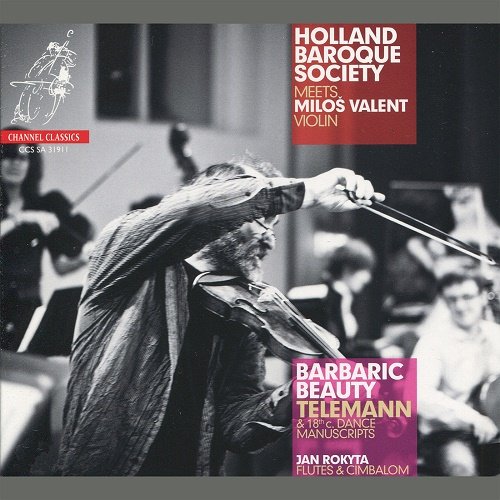
Holland Baroque Society & Miloš Valent - Telemann: Barbaric Beauty 18th Century Dance Transcriptions (2011) Hi-Res
BAND/ARTIST: Holland Baroque Society & Miloš Valent
- Title: Telemann: Barbaric Beauty 18th Century Dance Transcriptions
- Year Of Release: 2011
- Label: Channel Classics Records
- Genre: Classical
- Quality: FLAC (tracks) / FLAC (24bit/192kHz)
- Total Time: 1:17:28
- Total Size: 374 Mb / 2.37 Gb
- WebSite: Album Preview
Tracklist:
1. Perpetuum Mobile / Concerto Polonois in G: Dolce / Polonaise in D / Dance 90 / Polonesie / Pode Dworem D 79 / Polonesie I, II / Melodiarium / Concerto Polonois in B: Largo / Melodiurium G 11 / Concerto Polonois in G: Allegro (14:55)
2. Les Janissaires / Nota Kurucz I + II / Zela Trovke (6:17)
3. Mourky / Alkmaerder Hout, Murky, Overgaan Van Door-Nik / Les Moscovites / Dance 298 / Hungaricus 22 (10:25)
4. Dance 322 / Dopschensis / Adagio / Ach Ma Myla Co Myslis / Dance 325 / Melodiarium B-14 / Hungaricus 35 (11:51)
5. Hanaquoise / Songs: Dalat Mu Dala, Dobras Bila Kdy Te Milovali / Hanac I-II-III, Vivement (7:22)
6. Two Dances / En Kitzvo / Two Dances (11:41)
7. Marche / Verbung per il violino / Ungarici No. 2,3,5 Hungarice / Hungaricus 34 (5:55)
8. Mezzetin en Turc / Dance 277 / Les Turcs (9:04)
1. Perpetuum Mobile / Concerto Polonois in G: Dolce / Polonaise in D / Dance 90 / Polonesie / Pode Dworem D 79 / Polonesie I, II / Melodiarium / Concerto Polonois in B: Largo / Melodiurium G 11 / Concerto Polonois in G: Allegro (14:55)
2. Les Janissaires / Nota Kurucz I + II / Zela Trovke (6:17)
3. Mourky / Alkmaerder Hout, Murky, Overgaan Van Door-Nik / Les Moscovites / Dance 298 / Hungaricus 22 (10:25)
4. Dance 322 / Dopschensis / Adagio / Ach Ma Myla Co Myslis / Dance 325 / Melodiarium B-14 / Hungaricus 35 (11:51)
5. Hanaquoise / Songs: Dalat Mu Dala, Dobras Bila Kdy Te Milovali / Hanac I-II-III, Vivement (7:22)
6. Two Dances / En Kitzvo / Two Dances (11:41)
7. Marche / Verbung per il violino / Ungarici No. 2,3,5 Hungarice / Hungaricus 34 (5:55)
8. Mezzetin en Turc / Dance 277 / Les Turcs (9:04)
It goes without saying that Telemann had a thorough command of the French and Italian styles. Countless ensembles, including ours, have played such pieces. In ‘Barbaric Beauty’ we follow a completely different path by focussing on Telemann’s Polish style. At least, this is how he described the pieces he wrote after discovering the music played along the Polish-Hungarian border. It was at the beginning of his career, when he was just 25 years old, that he heard sounds that were to inspire him throughout his life. Telemann writes in his autobiography: “In 1704 I was appointed Chapelmaster in Sorau (Zary) by His Excellence Count Erdmann von Promnitz. When the Court resided for six months in Plesse and Krakow, I became acquainted with both Polish music and the music of the Hanaks. This in all its barbaric beauty. (The Hanaks are Czechs from Moravia) The music came from four different instruments: an extremely shrill violin, a Polish bagpipe, a bass trombone and a regal. On one occasion I even heard thirty-six bagpipes and eight violins together. One can hardly imagine the brilliant ideas the wind players and violinists brought forth during the improvisations at moments when the dancers were allowed to rest.” It is striking that Telemann was explicitly interested in the impro visa- tions, mentioning the ‘brilliant ideas’ for which there was only occasion when the band could free itself of the tight metre and musical require- ments of the dance. Telemann wrote with enthusiasm: “If you were to write down all that was played there, after a week you would have enough ideas for the rest of your life. If you know how to turn it to your own advantage, there is so much good to be had from this music.” He also wrote: “Later I wrote large-scale concertos and trios in this style, which I subsequently gave an Italian look to by alternating Adagios and Allegros.” Unfortunately, it cannot be established precisely what Telemann heard there. Although it cannot be confirmed, the 30 dances from the manuscript Danse d’Polonie which he wrote himself may well be literal quotes. What we do know is that the pieces from this so-called Polish dance book, which so inspired him, were clearly recycled later. They turn up in orchestral suites, for example in TWV 55:D3 where we hear the ‘Hanaquoise’, which he called Polonie in his manuscript. In TWV 55:B8 we find the ‘Mezzetin en Turc’, which he marked très vite in the Danse d’Polonie.
Classical | FLAC / APE | HD & Vinyl
As a ISRA.CLOUD's PREMIUM member you will have the following benefits:
- Unlimited high speed downloads
- Download directly without waiting time
- Unlimited parallel downloads
- Support for download accelerators
- No advertising
- Resume broken downloads


